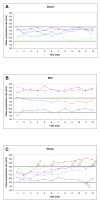Decay in chest compression quality due to fatigue is rare during prolonged advanced life support in a manikin model
- PMID: 21827652
- PMCID: PMC3169466
- DOI: 10.1186/1757-7241-19-46
Decay in chest compression quality due to fatigue is rare during prolonged advanced life support in a manikin model
Abstract
Background: The aim of this study was to measure chest compression decay during simulated advanced life support (ALS) in a cardiac arrest manikin model.
Methods: 19 paramedic teams, each consisting of three paramedics, performed ALS for 12 minutes with the same paramedic providing all chest compressions. The patient was a resuscitation manikin found in ventricular fibrillation (VF). The first shock terminated the VF and the patient remained in pulseless electrical activity (PEA) throughout the scenario. Average chest compression depth and rate was measured each minute for 12 minutes and divided into three groups based on chest compression quality; good (compression depth ≥ 40 mm, compression rate 100-120/minute for each minute of CPR), bad (initial compression depth < 40 mm, initial compression rate < 100 or > 120/minute) or decay (change from good to bad during the 12 minutes). Changes in no-flow ratio (NFR, defined as the time without chest compressions divided by the total time of the ALS scenario) over time was also measured.
Results: Based on compression depth, 5 (26%), 9 (47%) and 5 (26%) were good, bad and with decay, respectively. Only one paramedic experienced decay within the first two minutes. Based on compression rate, 6 (32%), 6 (32%) and 7 (37%) were good, bad and with decay, respectively. NFR was 22% in both the 1-3 and 4-6 minute periods, respectively, but decreased to 14% in the 7-9 minute period (P = 0.002) and to 10% in the 10-12 minute period (P < 0.001).
Conclusions: In this simulated cardiac arrest manikin study, only half of the providers achieved guideline recommended compression depth during prolonged ALS. Large inter-individual differences in chest compression quality were already present from the initiation of CPR. Chest compression decay and thereby fatigue within the first two minutes was rare.
Figures




Similar articles
-
Quality of chest compressions during 10min of single-rescuer basic life support with different compression: ventilation ratios in a manikin model.Resuscitation. 2008 Apr;77(1):95-100. doi: 10.1016/j.resuscitation.2007.11.009. Epub 2008 Jan 18. Resuscitation. 2008. PMID: 18207627
-
Incomplete chest wall decompression: a clinical evaluation of CPR performance by EMS personnel and assessment of alternative manual chest compression-decompression techniques.Resuscitation. 2005 Mar;64(3):353-62. doi: 10.1016/j.resuscitation.2004.10.007. Resuscitation. 2005. PMID: 15733766 Clinical Trial.
-
Improved neurological outcome with continuous chest compressions compared with 30:2 compressions-to-ventilations cardiopulmonary resuscitation in a realistic swine model of out-of-hospital cardiac arrest.Circulation. 2007 Nov 27;116(22):2525-30. doi: 10.1161/CIRCULATIONAHA.107.711820. Epub 2007 Nov 12. Circulation. 2007. PMID: 17998457
-
2017 American Heart Association Focused Update on Pediatric Basic Life Support and Cardiopulmonary Resuscitation Quality: An Update to the American Heart Association Guidelines for Cardiopulmonary Resuscitation and Emergency Cardiovascular Care.Circulation. 2018 Jan 2;137(1):e1-e6. doi: 10.1161/CIR.0000000000000540. Epub 2017 Nov 6. Circulation. 2018. PMID: 29114009 Review.
-
Chest compression components (rate, depth, chest wall recoil and leaning): A scoping review.Resuscitation. 2020 Jan 1;146:188-202. doi: 10.1016/j.resuscitation.2019.08.042. Epub 2019 Sep 16. Resuscitation. 2020. PMID: 31536776
Cited by
-
Quality of clinical care provided during simulated pediatric cardiac arrest: a simulation-based study.Can J Anaesth. 2020 Jun;67(6):674-684. doi: 10.1007/s12630-020-01665-w. Epub 2020 Apr 28. Can J Anaesth. 2020. PMID: 32347460 English.
-
Performance of cardiopulmonary resuscitation during prolonged basic life support in military medical university students: A manikin study.World J Emerg Med. 2015;6(3):179-85. doi: 10.5847/wjem.j.1920-8642.2015.03.003. World J Emerg Med. 2015. PMID: 26401177 Free PMC article.
-
Different Resting Methods in Improving Laypersons Hands-Only Cardiopulmonary Resuscitation Quality and Reducing Fatigue: A Randomized Crossover Study.Resusc Plus. 2021 Nov 12;8:100177. doi: 10.1016/j.resplu.2021.100177. eCollection 2021 Dec. Resusc Plus. 2021. PMID: 34825237 Free PMC article.
-
Chest Compression Quality in a Newborn Manikin: A Randomized Crossover Trial (August 2016).IEEE J Transl Eng Health Med. 2018 Sep 4;6:1900405. doi: 10.1109/JTEHM.2018.2863359. eCollection 2018. IEEE J Transl Eng Health Med. 2018. PMID: 30245943 Free PMC article.
-
Effect of rotating providers on chest compression performance during simulated neonatal cardiopulmonary resuscitation.PLoS One. 2022 Mar 14;17(3):e0265072. doi: 10.1371/journal.pone.0265072. eCollection 2022. PLoS One. 2022. PMID: 35286358 Free PMC article.
References
-
- Koster RW, Baubin MA, Bossaert LL, Caballero A, Cassan P, Castren M, Granja C, Handley AJ, Monsieurs KG, Perkins GD, Raffay V, Sandroni C. European Resuscitation Council Guidelines for Resuscitation 2010 Section 2. Adult basic life support and use of automated external defibrillators. Resuscitation. 2010;81:1277–1292. doi: 10.1016/j.resuscitation.2010.08.009. - DOI - PMC - PubMed
-
- Berg RA, Hemphill R, Abella BS, Aufderheide TP, Cave DM, Hazinski MF, Lerner EB, Rea TD, Sayre MR, Swor RA. Part 5: adult basic life support: 2010 American Heart Association Guidelines for Cardiopulmonary Resuscitation and Emergency Cardiovascular Care. Circulation. 2010;122:S685–705. doi: 10.1161/CIRCULATIONAHA.110.970939. - DOI - PubMed
Publication types
MeSH terms
LinkOut - more resources
Full Text Sources
Medical
Research Materials
Miscellaneous

